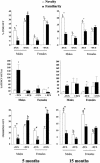Long-term effect of in vitro culture of mouse embryos with serum on mRNA expression of imprinting genes, development, and behavior
- PMID: 15079084
- PMCID: PMC395892
- DOI: 10.1073/pnas.0308560101
Long-term effect of in vitro culture of mouse embryos with serum on mRNA expression of imprinting genes, development, and behavior
Abstract
The long-term developmental and behavioral consequences of mammalian embryo culture are unknown. By altering the culture medium with the addition of FCS, we wanted to determine whether mouse embryos cultured under suboptimal conditions develop aberrant mRNA expression of imprinting genes at the blastocyst stage and whether fetal development, growth, and behavior of adult mice are affected. One-cell embryos obtained from superovulated female B6CBAF(1) mice were cultured for 4 days in K(+)-modified simplex optimized medium in the presence of either 10% FCS or 1 g/liter BSA. After embryo transfer, born animals were submitted to several developmental and behavior tests. The mRNA expression of some imprinting genes was significantly affected in blastocysts cultured in the presence of FCS. Two of the eight measures of preweaning development and some specific measures of neuromotor development, such as the walking activity, were delayed in the group originated with FCS. After 34 weeks, the weight of female mice cultured in vitro in the presence of FCS was significantly higher than controls. In addition, the locomotion activity of mice was altered at 5 and 15 months. Anatomopathological and histological analysis of animals at 20 months of age showed some large organs and an increase in pathologies. We have found that mice derived from embryos cultured with FCS exhibited specific behavioral alterations in anxiety and displayed deficiencies in implicit memories. Our data indicate that long-term programming of postnatal development, growth, and physiology can be affected irreversibly during the preimplantation period of embryo development by suboptimal in vitro culture.
Figures



Similar articles
-
Culture of preimplantation mouse embryos affects fetal development and the expression of imprinted genes.Biol Reprod. 2001 Mar;64(3):918-26. doi: 10.1095/biolreprod64.3.918. Biol Reprod. 2001. PMID: 11207209
-
The loss of imprinted DNA methylation in mouse blastocysts is inflicted to a similar extent by in vitro follicle culture and ovulation induction.Mol Hum Reprod. 2016 Jun;22(6):427-41. doi: 10.1093/molehr/gaw013. Epub 2016 Feb 7. Mol Hum Reprod. 2016. PMID: 26908643
-
Assisted Reproductive Technology affects developmental kinetics, H19 Imprinting Control Region methylation and H19 gene expression in individual mouse embryos.BMC Dev Biol. 2007 Oct 18;7:116. doi: 10.1186/1471-213X-7-116. BMC Dev Biol. 2007. PMID: 17949482 Free PMC article.
-
Long-term and transgenerational effects of in vitro culture on mouse embryos.Theriogenology. 2012 Mar 1;77(4):785-93. doi: 10.1016/j.theriogenology.2011.07.016. Theriogenology. 2012. PMID: 21855990 Review.
-
Suboptimal in vitro culture conditions: an epigenetic origin of long-term health effects.Mol Reprod Dev. 2007 Sep;74(9):1149-56. doi: 10.1002/mrd.20746. Mol Reprod Dev. 2007. PMID: 17474101 Review.
Cited by
-
Effects of light on development of mammalian zygotes.Proc Natl Acad Sci U S A. 2007 Sep 4;104(36):14289-93. doi: 10.1073/pnas.0706687104. Epub 2007 Aug 20. Proc Natl Acad Sci U S A. 2007. PMID: 17709739 Free PMC article.
-
Mouse maternal systemic inflammation at the zygote stage causes blunted cytokine responsiveness in lipopolysaccharide-challenged adult offspring.BMC Biol. 2011 Jul 19;9:49. doi: 10.1186/1741-7007-9-49. BMC Biol. 2011. PMID: 21771319 Free PMC article.
-
Epigenetics and Neurological Disorders in ART.Int J Mol Sci. 2019 Aug 26;20(17):4169. doi: 10.3390/ijms20174169. Int J Mol Sci. 2019. PMID: 31454921 Free PMC article. Review.
-
Maternal and zygotic Dnmt1 are necessary and sufficient for the maintenance of DNA methylation imprints during preimplantation development.Genes Dev. 2008 Jun 15;22(12):1607-16. doi: 10.1101/gad.1667008. Genes Dev. 2008. PMID: 18559477 Free PMC article.
-
Effects of ooplasm transfer on paternal genome function in mice.Hum Reprod. 2009 Nov;24(11):2718-28. doi: 10.1093/humrep/dep286. Epub 2009 Aug 6. Hum Reprod. 2009. PMID: 19661122 Free PMC article.
References
-
- Bavister, B. D. (1995) Hum. Reprod. Update 1, 91–148. - PubMed
-
- McEvoy, T. G. (2003) Reprod. Dom. Anim. 38, 268–275. - PubMed
-
- Walker, S. K., Hartwick, K. M. & Seamark, R. F. (1996) Theriogenology 45, 111–120.
-
- Young, L. E., Sinclair, K. D. & Wilmut, I. (1998) Rev. Reprod. 3, 155–163. - PubMed
-
- Gardner, D. K. (1994) Cell Biol. Int. 18, 1163–1179. - PubMed
Publication types
MeSH terms
Substances
LinkOut - more resources
Full Text Sources
Other Literature Sources
Medical

